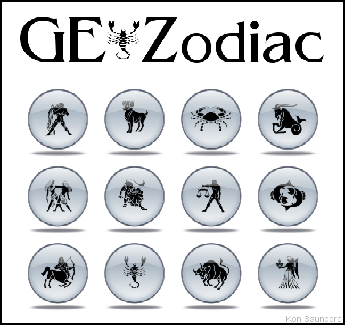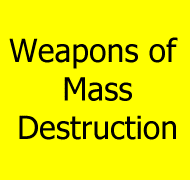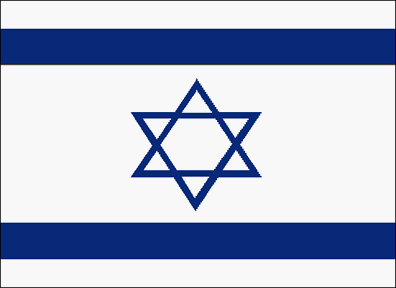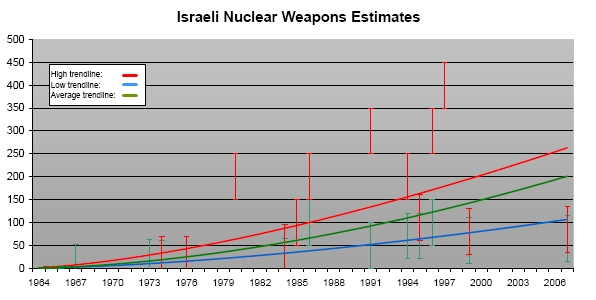[EMPIRE VAMPIRE Tattler]
<Warning!> The non-Brainwashed
Will be CULLED from the HERD First !
(otherwise, How would we get away with Depopulating
80% of the remaining Planet's Populatiom ?)
=
Israeli Nuclear Weapons is a "Public Secret"
FAS | Nuke | Guide | Israel |||| Search | Join FAS
Nuclear Weapons
Israel has not confirmed that it has nuclear weapons
and officially maintains that it will not be the first country
to introduce nuclear weapons into the Middle East.
Yet the existence of Israeli nuclear weapons is a "public secret"
by now due to the declassification of large numbers
of formerly highly classified US government documents
which show that the United States by 1975
was convinced that Israel had nuclear weapons.
History
Israel began actively investigating the nuclear option
from its earliest days. In 1949, HEMED GIMMEL a special unit
of the IDF's Science Corps, began a two-year geological survey
of the Negev desert with an eye toward the discovery
of uranium reserves. Although no significant sources of uranium
were found, recoverable amounts were located in phosphate deposits.
The program took another step forward with the creation
of the Israel Atomic Energy Commission (IAEC) in 1952.
Its chairman, Ernst David Bergmann, had long advocated
an Israeli bomb as the best way to ensure
"that we shall never again be led as lambs to the slaughter."
Bergmann was also head of the Ministry of Defense's Research
and Infrastructure Division (known by its Hebrew acronym, EMET),
which had taken over the HEMED research centers
(HEMED GIMMEL among them, now renamed Machon 4)
as part of a reorganization. Under Bergmann, the line between
the IAEC and EMET blurred to the point that Machon 4
functioned essentially as the chief laboratory for the IAEC.
By 1953, Machon 4 had not only perfected a process
for extracting the uranium found in the Negev,
but had also developed a new method of producing heavy water,
providing Israel with an indigenous capability to produce
some of the most important nuclear materials.
For reactor design and construction, Israel sought
the assistance of France. Nuclear cooperation between
the two nations dates back as far as early 1950's,
when construction began on France's 40MWt heavy water reactor
and a chemical reprocessing plant at Marcoule.
France was a natural partner for Israel and both governments
saw an independent nuclear option as a means by which
they could maintain a degree of autonomy
in the bipolar environment of the cold war.
In the fall of 1956, France agreed to provide Israel
with an 18 MWt research reactor.
However, the onset of the Suez Crisis a few weeks later
changed the situation dramatically. Following Egypt's closure
of the Suez Canal in July, France and Britain had agreed
with Israel that the latter should provoke a war with Egypt
to provide the European nations with the pretext
to send in their troops as peacekeepers to occupy
and reopen the canal zone.
In the wake of the Suez Crisis, the Soviet Union
made a thinly veiled threat against the three nations.
This episode not only enhanced the Israeli view
that an independent nuclear capability was needed
to prevent reliance on potentially unreliable allies,
but also led to a sense of debt among French leaders
that they had failed to fulfill commitments made to a partner.
French premier Guy Mollet is even quoted as saying privately
that France "owed" the bomb to Israel.
On 3 October 1957, France and Israel signed a revised agreement
calling for France to build a 24 MWt reactor (although the cooling
systems and waste facilities were designed to handle three times
that power) and, in protocols that were not committed to paper,
a chemical reprocessing plant.
This complex was constructed in secret, and outside the IAEA
inspection regime, by French and Israeli technicians at Dimona,
in the Negev desert under the leadership of Col. Manes Pratt
of the IDF Ordinance Corps.
Both the scale of the project and the secrecy involved
made the construction of Dimona a massive undertaking.
A new intelligence agency, the Office of Science Liasons,(LEKEM)
was created to provide security and intelligence for the project.
At the height construction, some 1,500 Israelis
some French workers were employed building Dimona.
To maintain secrecy, French customs officials were told
that the largest of the reactor components, such as the reactor tank,
were part of a desalinization plant bound for Latin America.
In addition, after buying heavy water from Norway on the condition
that it not be transferred to a third country, the French Air Force
secretly flew as much as four tons of the substance to Israel.
Trouble arose in May 1960, when France began to pressure Israel
to make the project public and to submit to international inspections
of the site, threatening to withhold the reactor fuel unless they did.
President de Gaulle was concerned that the inevitable scandal
following any revelations about French assistance with the project,
especially the chemical reprocessing plant, would have
negative repercussions for France's international position,
already on shaky ground because of its war in Algeria.
At a subsequent meeting with Ben-Gurion, de Gaulle offered
to sell Israel fighter aircraft in exchange for stopping work
on the reprocessing plant, and came away from the meeting
convinced that the matter was closed. It was not.
Over the next few months, Israel worked out a compromise.
France would supply the uranium and components already
placed on order and would not insist on international inspections.
In return, Israel would assure France that they had no intention
of making atomic weapons, would not reprocess any plutonium,
and would reveal the existence of the reactor, which would
be completed without French assistance.
In reality, not much changed - French contractors finished work
on the reactor and reprocessing plant, uranium fuel was delivered
and the reactor went critical in 1964.
http://www.fas.org/nuke/guide/israel/nuke/DIA1999.jpg
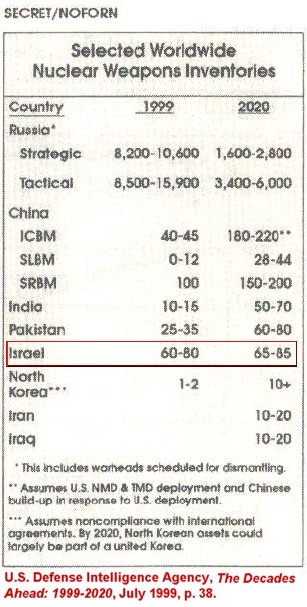
| DIA Estimate For Israeli Nuclear Weapons |
| Excerpt from 160-page secret DIA report, first disclosed and reproduced in Rowan Scarborough, Rumsfeld's War (Regnery, 2004), pp. 194-223. |

The United States first became aware of Dimona's existence
after U-2 overflights in 1958 captured the facility's construction,
but it was not identified as a nuclear site until two years later.
The complex was variously explained as a textile plant,
an agricultural station, and a metallurgical research facility,
until David Ben-Gurion stated in December 1960 that Dimona
complex was a nuclear research center built for "peaceful purposes."
There followed two decades in which the United States,
through a combination of benign neglect, erroneous analysis,
and successful Israeli deception, failed to discern first
the details of Israel's nuclear program.
As early as 8 December 1960, the CIA issued a report outlining
Dimona's implications for nuclear proliferation, and the CIA station
in Tel Aviv had determined by the mid-1960s that the Israeli
nuclear weapons program was an established and irreversible fact.
United States inspectors visited Dimona seven times
during the 1960s, but they were unable to obtain
an accurate picture of the activities carried out there, largely due
to tight Israeli control over the timing and agenda of the visits.
The Israelis went so far as to install false control room panels
and to brick over elevators and hallways that accessed
certain areas of the facility.
The inspectors were able to report that there was no clear
scientific research or civilian nuclear power program justifying
such a large reactor - circumstantial evidence of the Israeli bomb
program - but found no evidence of "weapons related activities"
such as the existence of a plutonium reprocessing plant.
Although the United States government did not encourage or
approve of the Israeli nuclear program, it also did nothing to stop it.
Walworth Barbour, US ambassador to Israel from 1961-73,
the bomb program's crucial years, primarily saw his job
as being to insulate the President from facts which might
compel him to act on the nuclear issue, alledgedly saying
at one point that
"The President did not send me there to give him problems.
He does not want to be told any bad news."
After the 1967 war, Barbour even put a stop to military attachés'
intelligence collection efforts around Dimona. Even when
Barbour did authorize forwarding information, as he did in 1966
when embassy staff learned that Israel was beginning
to put nuclear warheads in missiles, the message seemed
to disappear into the bureaucracy and was never acted upon.
Nuclear Weapons Production
In early 1968, the CIA issued a report concluding that Israel
had successfully started production of nuclear weapons.
This estimate, however, was based on an informal conversation
between Carl Duckett, head of the CIA's Office of Science
and Technology, and Edward Teller, father of the hydrogen bomb.
Teller said that, based on conversations with friends in the
Israeli scientific and defense establishment, he had concluded
that Israel was capable of building the bomb, and that the CIA
should not wait for an Israeli test to make a final assessment
because that test would never be carried out.
CIA estimates of the Israeli arsenal's size did not improve with time.
In 1974, Duckett estimated that Israel had between ten and twenty
nuclear weapons.
The upper bound was derived from CIA speculation regarding
the number of possible Israeli targets, and not from any specific
intelligence. Because this target list was presumed to be
relatively static, this remained the official American estimate
until the early 1980s.
The actual size and composition of Israel's nuclear stockpile
is uncertain and the subject of many - often conflicting
- estimates and reports. It is widely reported that Israel
had two bombs in 1967, and that Prime Minister Eshkol ordered
them armed in Israel's first nuclear alert during the Six-Day War.
It is also reported that, fearing defeat in the October 1973
Yom Kippur War, the Israelis assembled
13 twenty-kiloton atomic bombs.
Israel could potentially have produced a few dozen nuclear
warheads in the period 1970-1980, and is thought to have
produced sufficient fissile material to build 100 to 200 warheads
by the mid-1990s. In 1986 descriptions and photographs
of Israeli nuclear warheads were published in the
London Sunday Times of a purported underground bomb factory
at the Dimona nuclear reactor.
The photographs were taken by Mordechai Vanunu, a dismissed
Israeli nuclear technician. His information led some experts
to conclude that Israel had a stockpile of 100 to 200 nuclear devices
at that time.
By the late 1990s the U.S. Intelligence Community estimated
that Israel possessed between 75-130 weapons,
based on production estimates. T
he stockpile would certainly include warheads for mobile
Jericho-1 and Jericho-2 missiles, as well as bombs for Israeli aircraft,
and may include other tactical nuclear weapons of various types.
Some published estimates even claimed that Israel might have
as many as 400 nuclear weapons by the late 1990s.
We believe these numbers are exaggerated, and that Israel's
nuclear weapons inventory may include less than 100 nuclear weapons.
Stockpiled plutonium could be used to build additional weapons
if so decided.
http://www.fas.org/nuke/guide/israel/nuke/stockpilegraph.jpg
The Dimona nuclear reactor is the source of plutonium for Israeli
nuclear weapons. The number of nuclear weapons that could have
been produced by Israel has generally been estimated on the basis
of assumptions about the power level of this reactor,
combined with estimates for the number of delivery vehicles
(aircraft, missiles) assigned a nuclear mission.
Information made public in 1986 by Mordechai Vanunu indicated
that at that time, weapons grade plutonium was being produced
at a rate of about 40 kilograms annually. If this figure corresponded
with the steady-state capacity of the entire Dimona facility,
analysts suggested that the reactor might have a power level
of at least 150 megawatts, about twice the power level
at which is was believed to be operating around 1970.
To accommodate this higher power level, analysts had suggested
that Israel had constructed an enlarged cooling system.
An alternative interpretation of the information supplied
by Vanunu was that the reactor's power level had remained
at about 75 megawatts, and that the production rate of plutonium
in the early 1980s reflected a backlog of previously generated material.
The constraints on the size of Israel's stockpile include several


